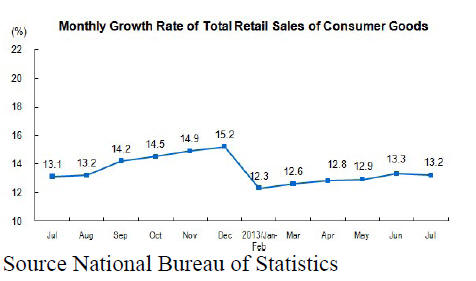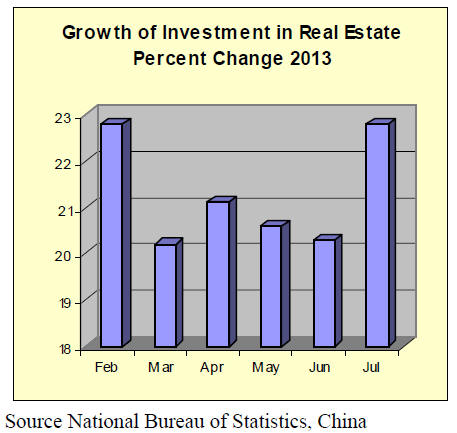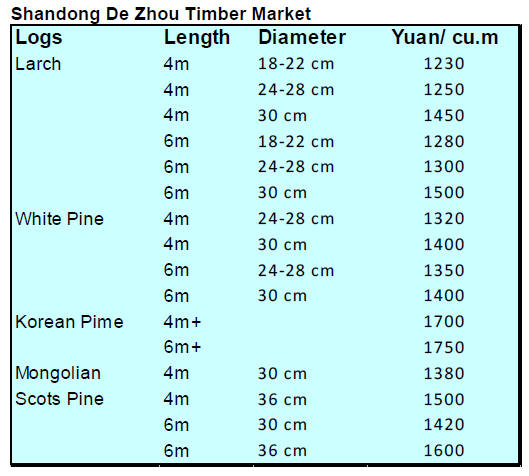US Dollar Exchange Rates of
27th
August 2013
China Yuan 6.1206
Report from China
Retail sales deliver good performance
In July total consumer goods retail sales reached yuan 1,851 billion up
13 percent year-on-year according to a press release from the National
Bureau of Statistics of China.
See:
http://www.stats.gov.cn/english/pressrelease/t20130809_402918316.htm
Of the total, retail sales of consumer goods by industrial enterprises
surveyed was yuan 916 billion, an increase of 11 percent. From January
to July, retail sales of consumer goods were up by 12.8 percent
year-on-year.
Retail sales of furniture in July totalled yuan 15 billion up 17 percent
year on year and between January and July this year furniture sales
increased 20.7 percent.

Real estate investment increases but land purchases slip
The National Bureau of Statistics of China recently released details of
real estate investment between January and July 2013.
See:
http://www.stats.gov.cn/english/pressrelease/t20130809_402918312.htm
Investment in real estate in the first seven months of this year grew by
20.5 percent year-on-year but the pace of growth eased slightly in July.
Investment in residential buildings was yuan 3,031.8 billion, up by 20.2
percent, 0.6 percent lower than that in the first six months and
accounted for 68.4 percent of real estate development investment.
Real estate investment from January to July in the eastern region was up
18.6 percent year-on-year, growth in the central region was up by 21.0
percent and growth in the western region improved by 25.0 percent.
In the same period the floor space under construction by the real estate
developers rose 16.2 percent year-on-year while the land area purchased
by real estate developers fell 1.4 percent year on year.

Plywood anti dumping investigations by Colombia, Argentina and S. Korea
In mid July this year the Colombian Ministry of Trade and Industry
decided to investigate the pricing of Chinese plywood entering the
country. This anti-dumping investigation focused on imports of plywood
defined under the HS codes 4412 3100.00 and No. 4412 3200.00.
This followed a similar decision made by the Argentine Foreign Trade
National Affairs Secretariat, in the Ministry of Economy and Public
Finance.
In related news, South Korea¡¯s trade commission in the Ministry of
Trade, Industry and Energy, has proposed anti-dumping duties on imports
of Chinese made plywood for the next three years.
The duties proposed will range from 2.4 percent to 27 percent but the
South Korean Ministry of Strategy and Finance is yet to make a decision
on this.
The plywood market in South Korea is estimated to be worth around US$800
million and Chinese made plywood accounted for roughly 40 percent market
share in 2012.
No more Customs inspection for many forest products
Measures to simplify export clearance procedures and thereby reduce
operational costs and hopefully encourage competitive exports have been
introduced.
As of 15 August the State General Administration of China Quality
Supervision, Inspection and Quarantine, and the State General
Administration of China Customs will no longer be inspecting a wide
range of wood product exports.
However, 26 wood-based panel products such as bamboo-based plywood where
each layer is less than 6mm thick and multi-layer plywood panels with at
least one surface made from non-coniferous wood will still require
inspection.
Many analysts are questioning why exporters of non-coniferous surfaced
panels will still have to submit to costly inspections. But the
authorities in China appear to trying to effect a change in the
structure of the wood product manufacturing sector.
Further support for manufacturers, especially small companies, in the
form of suspension of the value-added tax and turnover tax for small
businesses with monthly sales of less than yuan 20,000 has been
welcomed.
The government has said this would benefit around six million small
companies in all sectors and will boost employment.
Wooden handicraft subject to tighter inspections
The State General Administration for Quality Supervision, Inspection and
Quarantine has issued a new regulation on inspection of wooden
handicraft products destined for the US market. Beginning 24 July only
wooden handicraft satisfying the new regulation can be exported to the
US.
The new regulations identifies the products involved as primarily
processed wooden handcrafts made from natural materials such as bamboo,
wood, rattan and willows and also includes carvings, baskets, boxes,
outdoor items, dried flowers, artificial trees, lattice towers, garden
fences and other primary processed wood products.
The regulation requires that wooden handicraft producers must register
at local entry-exit inspection and quarantine agencies providing
information on production facilities, quarantine processes, quality
control and raw material tracking controls.
The entry-exit inspection and quarantine agencies have the power to
suspend exports by businesses not complying with the regulations.
To ensure the effective implementation of tracking and operational
procedures the State Administration for Quality Supervision, Inspection
and Quarantine regularly reviews implementation of the regulations.
Wooden frame buildings have bright future in China
Experts are urging development of standards for wooden structures
claiming the technologies being applied at present need to be updated.
It has been noted that traditional wooden frame Chinese buildings offer
advantages over other forms of buildings in terms of the time taken to
complete a structure, better heat insulation and better quake
resistance. Wooden buildings are said to have a bright future in China.
Currently, China has 21 national wood-frame building related standards
and 17 sector standards as well as technical standards for lumber and
laminated providing a good foundation for the further development of
standards. It is recognized that the wood frame building sector would
benefit from expanded standards.
Weak flooring market dampens demand for imported timber
In the first half this year the volume of raw materials used in the
solid wood flooring sector in China fell sharply. The main reasons for
the decline were weak domestic and international market demand and
increased costs for raw materials used in the industry.
Analysts report that it is likely that imports of raw materials for
solid wood floors will fall further.


¡¡
|